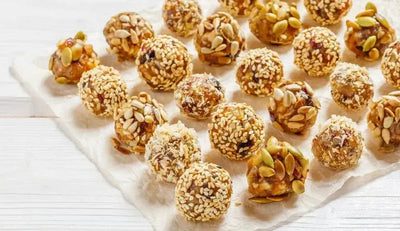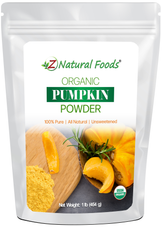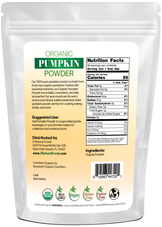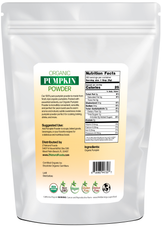Description
Description
October and autumn are a magical time of year. In many places, it is a time for festivals, the harvesting of apples, the creation of new beer flavors, and the beautiful changing of the leaves.
However, the most beloved symbol of autumn is a versatile and delicious fruit: pumpkins. Yes, we called them fruit because fruits are defined as the edible body of a seed plant.
Pumpkins, also known as winter squash, are a part of the Cucurbitaceae family, which contains over 900 species, including melons and cucumbers.
Z Natural Foods' mission is to provide customers with great-tasting, highly functional foods with limitless applications in their most versatile form to support a healthy, vibrant life.
So, in today’s article, we will discuss the nourishing benefits of consuming pumpkin powder.
The Benefits of Eating Pumpkin and Pumpkin Powder
Pumpkins are considered one of the most versatile foods because all parts are edible.
- Pumpkins tolerate high heat well and can be steamed, boiled, or baked, making hearty pies and soups.
- The flesh is used to make bread, pasta, pancakes, and a version of mashed potatoes.
- The seeds are a popular snack and are used to make protein powders.
- While the pumpkin rind takes time to break down, it has many fantastic functions as a food.
- Whether cooked in a soup, used in jams to enhance its clean and creamy taste, or seasoned with olive oil and salt and baked with other vegetables, there is no good reason to waste a good pumpkin rind.
- The pumpkin leaves are often treated like spinach but can also be used similarly to grape leaves in Mediterranean cuisine.
- While immensely popular in salads, adding a sweet and slightly earthy flavor, pumpkin flowers are most well known for being stuffed with meat or cheese, battered and deep fried for a delicious treat.
- The average protein content of pumpkin seeds is 60-75%, and their biological value is between 73% and 86%. However, NPU (net protein utilization) has yet to be established for pumpkin seed protein.
- The primary unsaturated fatty acid components found in pumpkin seeds are as follows: Palmitic 15%, Stearic 8%, Oleic 47%, and Linoleic 61%
Pumpkin Power Improves flavor and texture profile
Two factors most people consider essential when consuming food are taste and texture. Let's face it; no one wants to eat something that tastes terrible or has an unappealing texture.
When used correctly, changing the flavor and texture of a food or dish is one area where pumpkin powder can really shine. Adding it to any dessert or smoothie by sprinkling a heaping tablespoon on top instantly supports a well-balanced flavor profile.
The Mildly sweet flavor of pumpkin powder may enhance a bland or unappealing food or recipe and provide your palate with just enough, but not too much.
Pumpkins: A Treasure Trove of Nourishment
All nourishing foods of color contain a wide array of compounds that have been verified by research to benefit human biochemistry.
Each one of these foods has a superstar compound that they are known for containing. Pumpkin seeds are known to contain fourteen flavonoids and ten phenolic acids.
However, the superstar in pumpkins is the family of compounds known as carotenoids.
Carotenoids
Carotenoids are a class of red, orange, or yellow fat-soluble pigments produced by plants, algae, and photosynthetic bacteria.
There are more than 600 types of carotenoids (some of the most common include alpha and beta carotene, lycopene, lutein, and beta-cryptoxanthin), all with unique attributes that are researched for their ability to take on antioxidant-like qualities potentially.
Carotenoids are classified into two primary groups: Xanthophylls (primarily protect from too much sunlight, contain oxygen, more yellow pigment, and are associated with nourishing the eyes), which closely associate with green leafy vegetables, and Carotenes (have no oxygen and are associated with orange pigment). Pumpkin has been said to be an outstanding source of lutein and zeaxanthin.
According to the American Macular Degeneration Foundation, one cup of pumpkin provides 2.5 mg of lutein and zeaxanthin.
Quercetin
While apples, onions, and moringa are the “foods of choice” when acquiring quercetin, pumpkins are also a source of this potent flavonoid.
Among the compounds researchers have discovered in pumpkin byproducts, flavinoids were the most abundant, including the O-glycosylated quercetin derivatives. Quercetin has been spoken of as one of the most potent flavonols, and a little bit goes a long way.
Quercetin is being aggressively studied for its ability to support a healthy aging process through multiple mechanisms of action. In one human study, quercetin showed its ability to inhibit inflammation by increasing peroxisome proliferator-activated receptors(PPARy), which was shown to antagonize nuclear factor kappa b (NFKB), a protein complex at the top of the inflammation cascade that controls transcription of DNA, cytokine production, and cell proliferation.
The following was stated in a review of the biochemical constituents of pumpkins and their role as Pharma Foods.
- “Pumpkins are well equipped with nutraceuticals and functional bio-actives like tocopherols, polyphenols, terpenoids, and lutein; therefore, consumption and processing of this remarkable vegetable could be encouraged as pharma food due to its antihyperlipidemic, antiviral, anti-inflammatory, antihyperglycemic, immunomodulatory, antihypertensive, antimicrobial and antioxidant potential.”
- “Significant amount of minerals (potassium, iron, zinc, copper, magnesium, selenium, and phosphorus) and phytochemicals (α tocopherol, β tocopherol, γ tocopherol, β sitosterol, stigmasterol, squalene, and β carotene) have been quantified from different varieties of pumpkins, and extracts from pumpkin were found involved in antimicrobial activities against different bacterial and fungal strains.”
- “Pumpkin seed oil is a good source of edible oil and protein as it contains 41.59% fat and 25.4% protein. Further proximate analysis of pumpkin seeds reported moisture at 5.2%, crude fiber at 5.34%, total ash at 2.49%, and carbohydrates at 25.19%.”
Finally, the following was stated in a study discussing the effects of Pumpkin, beta carotene, and a forced swimming test had on depressive behavior.
- After 28 days, treatment with SSP and β-carotene significantly decreased the immobility time during the FST.
- SSP significantly increases the levels of serotonin and norepinephrine in the brain.
- BDNF, pERK, and ER-β levels significantly increased in the SSP- and β-carotene-administered groups compared with the control group.
- The groups treated with SSP and β-carotene showed significantly reduced levels of tumor necrosis factor-alpha and interleukin-6 compared with the control group.
Therefore, it was concluded that pumpkin and beta carotene have the potential as therapeutic agents in the treatment of depression.
In conclusion, both fresh and powdered pumpkin are outstanding essential functional foods that provide tremendous versatility and have limitless applications and culinary uses.
So, whether you are looking for a clean and natural flavor and texture enhancer or just a way to support nourishment levels, both the fresh and powdered versions of pumpkin are delicious ways to achieve your goals.

Creamy Pumpkin Sauce Recipe:
Ingredients:
- 1 pound fettuccine pasta Or your choice of pasta
- 6 tablespoons butter
- 2 garlic cloves minced
- 1/2 cup pumpkin powder
- 1/8 teaspoon nutmeg
- 1/2 Cup heavy cream powder
- Himalayan salt to test
- 1/2 cup freshly grated Parmesan cheese off the block
- 1 tablespoon fresh chopped parsley
Directions:
- Bring a stockpot of water to a boil over high heat. Add salt, and fettuccine. Cook until al dente. Reserve about 2 cup of the pasta water.
- In separate bowl mix pumpkin powder, heavy cream powder, nutmeg and add 1 cup pasta water mix well and make a Pumpkin sauce.
- Take sauce pan, melt butter over medium-low heat. Stir in garlic and cook for about a minute, add pumpkin sauce, and Parmesan. Stir until sauce is heated through and cheese is melted. Stir in pasta water, about ¼ cup at a time (or more water), until sauce is desired consistency.
- Add pasta and cook over medium-high heat until sauce is smooth and pasta is well coated; about 1-2 minutes.
- Garnish with fresh chopped parsley and fresh grated Parmesan, if desired.











